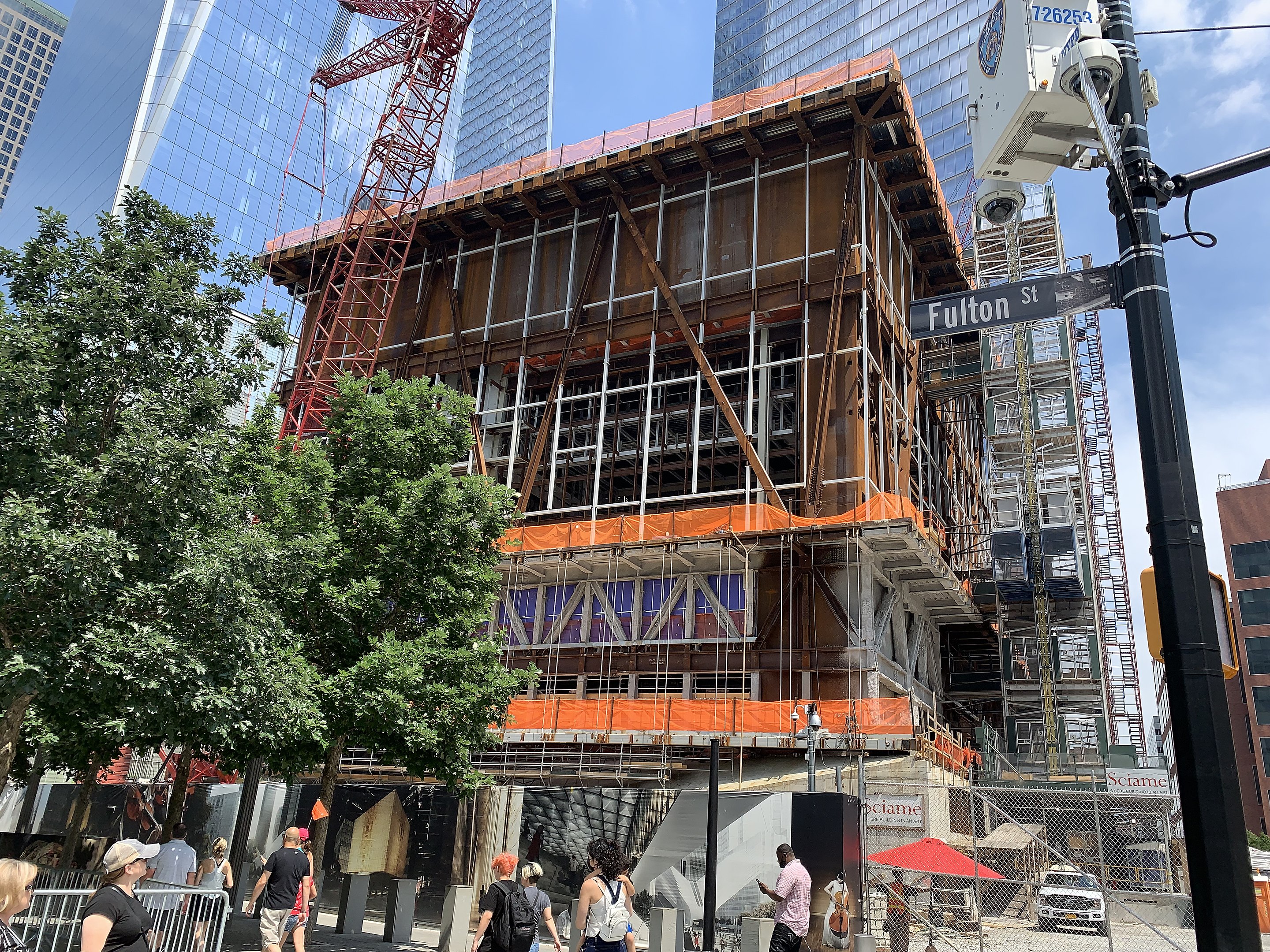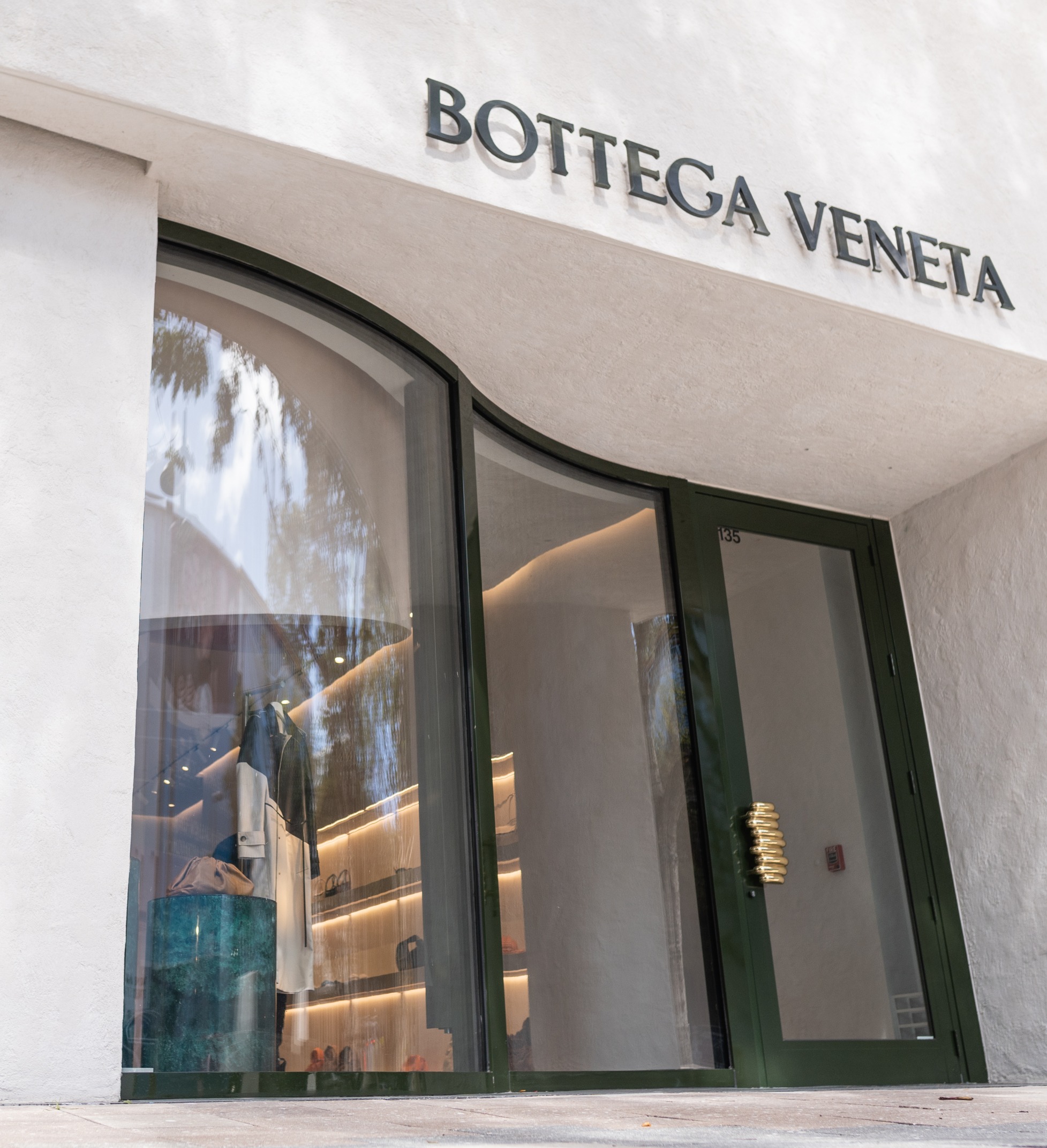Floodproof Window Systems and Glass Flood Walls
Passive systems provide superior design options
![]() Continuing Education
Continuing Education
Use the following learning objectives to focus your study while reading this month’s Continuing Education article.
Learning Objectives - After reading this article, you will be able to:
- Identify and compare the different types of floodproofing systems, including conventional, active, and passive dry floodproofing solutions.
- Review the current regulatory standards and requirements related to flood protection in buildings.
- Explain different types of passive systems including impact windows, floodproof windows, and flood walls that meet local, state, and federal regulations.
- Assess the costs of passive versus active dry floodproofing systems for buildings.
Flooding has become a more common occurrence in many locations prompting architects and other design professionals to seek ways to protect people and buildings from often damaging effects. Finding ways to achieve that protection so that buildings remain resilient, dry, and operational is a design challenge that needs to balance effectiveness with aesthetics and budget. Increasingly, such solutions also need to meet local, state, or federal standards to satisfy code requirements or insurability. In cases where a building is a critical facility, such as a hospital or emergency response control center, particular attention is needed for timely, effective, and permanent flood protection. With all these points in mind, this course looks at some of the options available, especially passive systems which remain permanently in place. Some floodproofing fundamentals are presented along with a variety of regulatory requirements. Then floodproof window systems and glass flood walls are looked at in detail including some project examples of very successful installations. These systems represent a fairly new technology that is leading to new options and a new future in flood protection for commercial buildings.
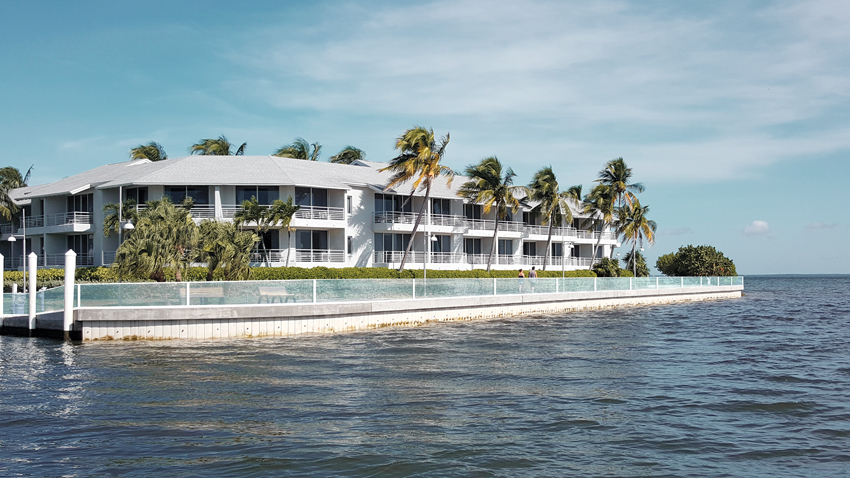
Photo courtesy of Floodproofing.com
Buildings that are located adjacent to, or near, bodies of water are subject to flooding. They must be protected for the occupants' safety and to avoid property damage.
Floodproofing Fundamentals
Different methods and techniques have been used for many years to protect buildings from flood damage and people from harm. Some are based on trial and error, some on tradition, and some newer ones are based on engineered, manufactured systems. All are primarily focused on keeping rising floodwater at bay and isolated from vulnerable portions of buildings. There are three, fundamental, common methods currently in use which are discussed as follows.
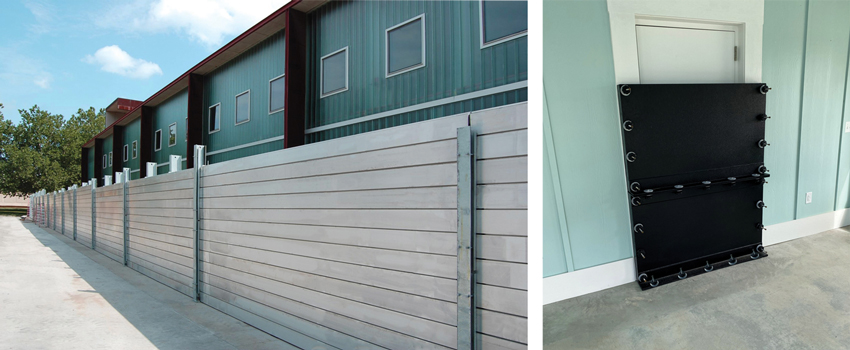
Photos courtesy of Floodproofing.com
Active floodproofing includes barriers or shields that are deployed as needed just before a flooding event.
Conventional Dry Floodproofing
Historically, the most common and conventional approaches to floodproofing have been reactionary, often relying on do-it-yourself methods of hand-installed materials. Sandbags are the most commonly used form of flood barrier, although their effectiveness can vary greatly based on the specific materials used and the stacking techniques employed. The idea is that the heavy bags will stay in place and form a barrier that can be custom fit to suit a particular location or application. They aren’t inherently waterproof, and the edges and perimeters are not particularly prone to a tight seal in all cases. The sand may actually get wet and store some water which may help in some cases, but certainly not in a severe condition.
Other hand-based responses include using plywood or similar wood board stock to cover over windows and doors to protect against not only water, but from flying or flowing debris. The effectiveness of this approach can also obviously vary a great deal based on the specific materials and the methods of installation.
Active Floodproofing
In locations where repeated flooding has occurred or the potential damage is high, more reliable methods have been sought for protection. This has led to the rise of engineered, manufactured barrier systems that can be erected around a building in advance of a flooding event and removed afterwards. Such systems include stackable barriers in frames, temporary flood walls or shields, among others. This manufactured approach provides a more reliable and predictable defense against flood waters since it allows for design and fabrication of a system that can be tested for effectiveness. If any weakness is found, it can be corrected and adjusted in advance, not only in the nature of the manufactured products, but also in the specific implementation or deployment for a particular building.
While active floodproofing is generally considered to be more effective than conventional, do-it-yourself floodproofing, there are some things that need to be considered. First, these systems are generally more expensive than conventional systems. They do have the benefit of being demountable and re-usable, however. That can make them quite economical over time, particularly if they avoid costly building damage and repairs. Second, they need to be readily available to the protected building, so there is the need (and cost) of providing storage for the parts and pieces of the system. Next there is the need for trained labor to take the system out of storage in advance of a flood event, install it in place correctly, and assure its watertight capabilities. This deployment may take hours or even days to achieve so speed is of the essence, particularly in cases where minimal advance warning is provided. These conditions may require extra personnel or equipment (forklifts, small cranes, etc.) to allow the system to be fully deployed rapidly and effectively.
It is important to note that some jurisdictions have adopted code or other requirements related to active floodproofing systems. Of particular concern to a building owner or operator is the common requirement for an annual deployment of the system to allow it to be inspected. This means that, at a minimum, a once-a-year effort and expense must be committed to assure that the active system remains an effective form of flood proofing a building or site.
Passive Floodproofing
Recognizing that manufactured active floodproofing systems bring both advantages and added requirements to a building, the search for a better option has led to the use of passive floodproofing systems. These are defined simply as a permanently installed system that remains in place and ready to protect all the time. Passive systems are designed and installed as part of the overall building or site design with the first intent of providing protection, just like security barriers can. In the interest of maintaining a cohesive building or site design, passive systems don’t need to look like engineered fortress barriers. Rather, the best ones provide some options and material choices that can allow these passive flood proof barriers to blend in as part of the overall design scheme.
Since passive floodproofing is a permanent feature of the building or site, it overcomes many of the concerns associated with active systems. The biggest advantage is that there is no deployment required – nothing needs to be set up or taken down for a flood event since the passive system is already there. That means there is no need for storage space to keep the system components when they are not in flood protection mode. No deployment also means that there is no need for personnel or other human intervention in advance of, or after, a flood event. Basically, the passive system is simply there, in plain sight, as part of the overall design, ready to always protect property and people. It may still mean that the system needs to be regularly inspected, but that is straightforward and does not require the time and expense of a full deployment just for the inspection.
Floodproofing Terminology
Beyond the fundamental differences between conventional, active, and passive systems, it is important to be familiar with the common terminology used in the design and construction of floodproof systems. The list shown here in this article is a good start since it describes the three basic terms related to flood elevations (i.e., the height of flood water above a reference point) and the types of hazard areas commonly referred to. It is very useful to be familiar with these terms and understand how they relate to the overall flood proofing process.
Regulatory Requirements for Floodproofing
The frequency and severity of flooding in both coastal areas and areas along rivers and other freshwater bodies, has prompted increased attention in the codes and standards that are used to keep buildings and people safe. A short summary follows of some of the national standards and requirements related to floodproofing of buildings.
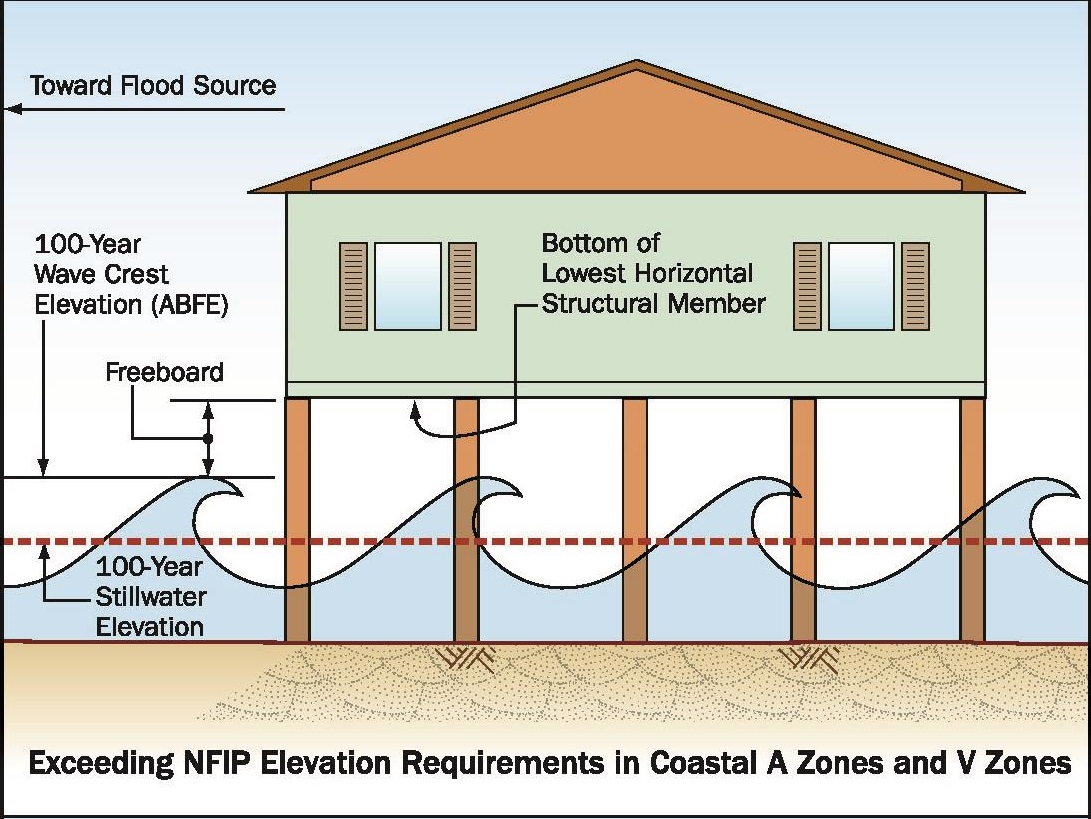
Image courtesy of FEMA.gov
International Building Code (IBC)
Section 1612.5 of the IBC addresses Flood hazard documentation. As with many provisions of the building code, the IBC relies on generally accepted standards in the industry. In this case, it points to a standard promulgated by the American Society of Civil Engineers (ASCE). IBC section 1612.5 – 1.3 states “For dry floodproofed nonresidential buildings, construction documents shall include a statement that the dry floodproofing is designed in accordance with ASCE 24.” For any design professional to include such a statement requires the proper attention and diligence to the standard and incorporation of the needed design elements into the building. Since some of those elements are typically structural and some are architectural, coordination is required between the architect and structural engineer with appropriate information on the construction documents.
ASCE-24 – Flood-Resistant Design and Construction
This standard covers the full range of topics and considerations for designing and constructing buildings to survive and be resilient in case of a flooding event. In particular, ASCE-24 addresses Dry Floodproofing as a combination of measures that results in a structure, including the attendant utilities and equipment, being watertight. That means all elements are substantially impermeable and structural components having the capacity to resist flood loads from hydrostatic pressure or wave action. The standard defines substantially impermeable to mean the maximum accumulation of 4 inches of water depth in a protected space during a period of 24 hours. Hence, the standard is not for complete waterproofing, but allows a small amount of water penetration.

Photo courtesy of Floodproofing.com
Passive floodproofing is integrated into a building design without the appearance of anything different, yet provides the needed protection without deployment.
FEMA/ NFIP Technical Bulletin 3
This guidance was issued in January 2021 by the Federal Emergency Management Agency (FEMA) National Flood Insurance Program (NFIP). Flood insurance is required for many buildings, including commercial and industrial (i.e., nonresidential) facilities. This Technical Bulletin clarifies “Requirements for the Design and Certification of Dry Floodproofed Non-Residential and Mixed-Use Buildings - Located in Special Flood Hazard Areas in accordance with the National Flood Insurance Program (NFIP).”
The goal of the program and this bulletin is to make a building watertight, impermeable to floodwaters, in other words, more stringent than the ASCE-24 standard. Specifically, the walls of a building need to be designed to be waterproofed plus take a flood load up to the Design Flood Elevation (DFE). Similarly, the United States Army Corps of Engineers (USACE) definition of “Substantially Impermeable” is to be watertight to 1 foot above the Base Flood Elevation (BFE). Neither case allows the accumulation of more than 4 inches of water. In addition to impermeable walls, flood barriers are required to protect openings such as doors, windows, or vehicular entrances which are not commonly floodproof.
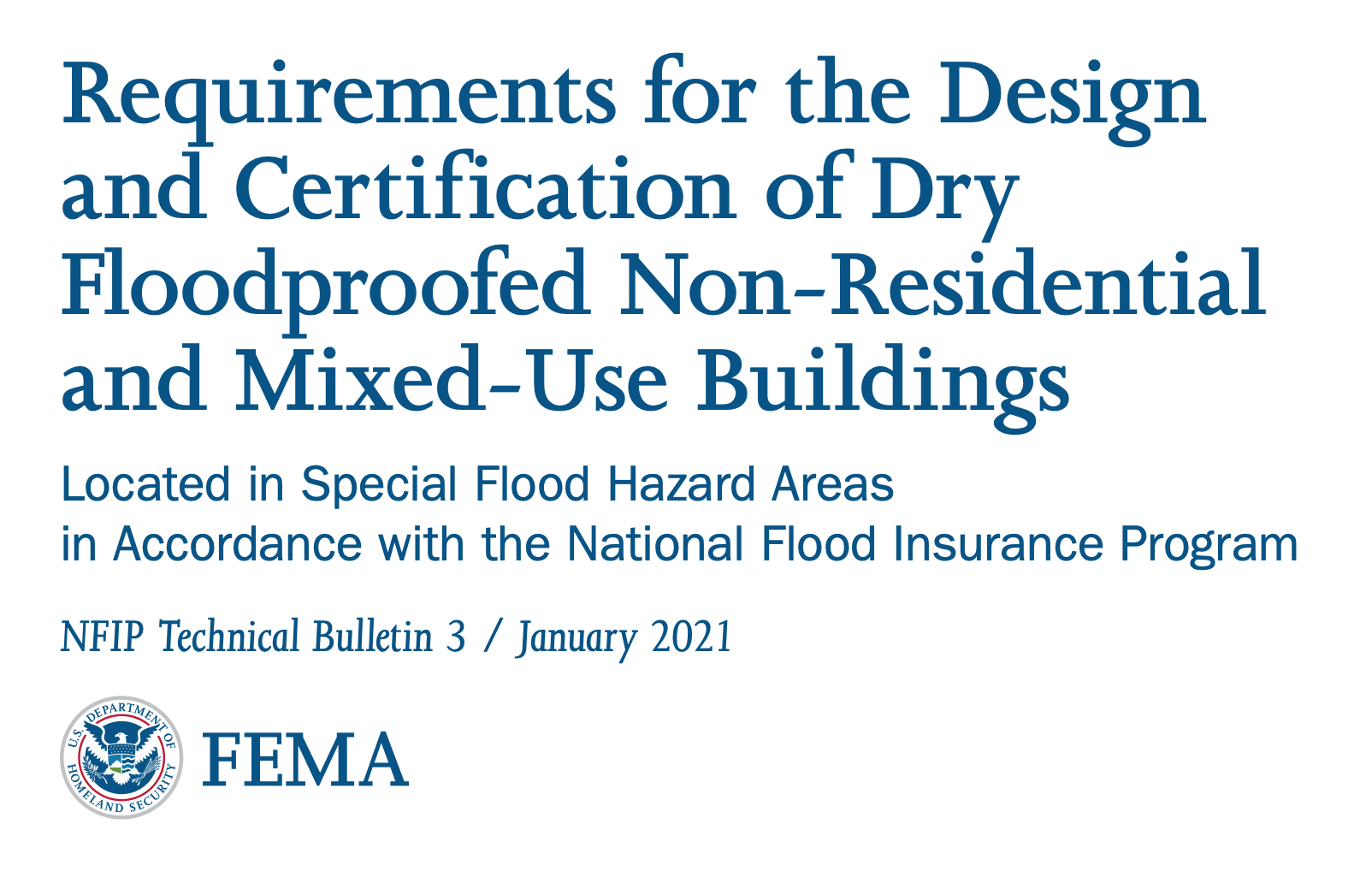
Credit: FEMA.gov; courtesy of Floodproofing.com
ASCE-24 and FEMA/NFIP Technical Bulletin 3 provide the basis for national standards for floodproofing design requirements.
Structural design considerations in this case include the ability to absorb impact from debris based on a 1,000-pound log traveling at 5 feet per second. The standard here is ASCE 7 - “Minimum Design Loads and Associated Criteria for Buildings and Other Structures,” which should be used as the source of how to calculate debris impact loads. In particular, ASCE 7, Section 6.11, requires designs to include the effects of debris impact forces in flood load calculations when the minimum inundation depth is 3 ft. or greater. Furthermore, all utilities and sanitary facilities must be protected in addition to the building components.
Note that dry floodproofing is acceptable under this standard in SFHA flood zones A, AE, A1-A30, AO, and AH. In all cases, the design must be certified by a design professional and/or by FEMA as suitable for protection.
There are some other considerations to be aware of that relate to regulatory requirements.
Periodic Testing
Beyond the initial design and construction, multiple standards call for periodic drills and deployment of active systems. ASCE 24, FEMA TB-3, and the NFIP Flood Insurance Manual require flood emergency and inspection plans approved by the authority having jurisdiction. Once the plan is approved, then the standards call for a periodic and annual deployment of dry floodproofing shields and barriers. The rationale is that, just like a fire drill, practice is needed to ensure the system will work. The maximum flood drill warning time is 12 hours. Then the floodproofing measures need to be installed within that warning time – i.e., under 12 hours. The results are documented, and the inspection is either considered successful or not. If need be, the drill may need to be repeated until compliance is achieved.
Local Regulations
Some localities have implemented their own requirements above and beyond the national standards which are also enforced locally. For example, ever since Hurricane Sandy, New York City requires, and is enforcing, flood drills, just like fire drills. Miami Dade County in Florida is known for its wind and severe weather requirements in buildings due to the prevalence of hurricanes there. Both of these cities, as well as others, are becoming well known for their design, construction, and periodic testing requirements for flood protection.
Ramifications of Noncompliance
There can be considerable problems if a building is found to be noncompliant related to any of these national or local regulations. First, the building could end up on the FEMA noncompliant list meaning it is regarded as a flood liability and the NFIP insurance may not cover it. Neither code enforcement officials nor design professionals want to see one of their buildings tagged this way since it transfers liability to them as a lack of enforcement or a lack of proper design.
There is also the need to be sure that if an active floodproofing solution is used, then it must be fully deployed when needed. If not, then business or operations continuity is compromised, not to mention the potential for major losses of property and lives being put at risk. Currently the NFIP pays out damage claims even if an active flood measure is not fully deployed. However, due to prior experiences this could change in the future. It is one thing if an active system is properly deployed and a larger than expected flood breaches over the top of the system – this can be seen as out of the control of building owner. But not deploying the system is like having a fire truck parked outside of a burning building and not turning on the water hose. NFIP may start to look at non-deployments in the same manner and limit damage claim payments as a result.
Now that we have reviewed some of the fundamentals of floodproofing and some of the regulatory requirements that need to be addressed, let’s turn our attention to a few design strategies that are proving to be effective and very appealing in many situations
Floodproof Window Systems
We have seen the need to create substantially impermeable conditions at and below the DFE. While opaque walls can be readily addressed for that condition, windows that extend below the DFE commonly require an active system to be deployed to protect them. An alternative is to specify and install a manufactured, passive, floodproof window system. These systems are currently available and offer the capability to be fully water impermeable while also providing the needed structural resistance to debris impact.
Floodproof window systems consist of a complete window product or fixed glass wall systems that are manufactured, fabricated, and delivered to the project site for a coordinated installation. The window units are custom sized to suit a building design, pre-glazed and sealed in a factory-controlled environment and engineered for proper anchoring to the building. delivered ready to be installed. This process eliminates any unnecessary handling of glass and frames and creates a higher quality product that is more cost-effective.
Design Attributes
Among the notable attributes of floodproof window systems, the most striking is that they are a passive system that is always ready – the floodproof windows are simply part of the glazing design of the building. Therefore, there is no need for installation before a storm nor for removal afterwards. That also means there is no need for the periodic or annual deployment as with an active system. The floodproof window systems may be subject to inspection, nonetheless, just like other permanent components of a building are, primarily to be sure that they are still properly in place, have not been damaged, or require any other maintenance
Photo courtesy of Floodproofing.com
Passive floodproof window systems can be used in a variety of building types to meet different design needs.
As a passive system, they also avoid some of the drawbacks of storing and deploying an active system. Active systems stored in basements or elsewhere may suffer from environmental corrosion, lack of maintenance, or lost pieces which inhibit their ability to be deployed easily and fully. When they are set in place, they often interfere with the pedestrian and vehicular pathways around the building such as sidewalks and drives. The passive floodproof window systems avoid all of these issues since they simply remain in place in the wall of the building.
From a performance standpoint, the available systems are independently tested following proper test standards. Some systems have demonstrated a tested compliance beyond the minimums in the regulations helping to ensure a level of safety and protection even in unexpected conditions. For example, some systems have been tested to be able to withstand up to 10 feet of standing water and still withstand the required 1,000 pounds of debris impact. Altogether, the combined attributes of these systems provide everyone involved with less concern about liability and risk management. As such, that may also translate to reduced insurance premiums for the building owner.
System Components
How do floodproof window systems achieve this combination of passive, integrated design and the needed performance? The answer is in the coordinated, engineered, nature of the different components that make up these systems.
- Glass The glass in the systems is, as might be expected, stronger than typical window glazing. Commonly, custom configured laminated glass is used that meets both building design needs and the strict testing standards for strength and impermeability. Laminated glass is commonly used in automobile windshields and buildings where security and vandal resistance are concerns. For this type of glazing, multiple layers of glass are laminated together with clear plastic or polymer interlayers. If the glass is struck by an impact, the clear interlayers help to hold it together. That is why an automobile windshield can look very cracked or damaged but is still intact or why a store window may be disfigured but won’t give way to repeated hits from a sledgehammer.
For floodproof windows, high modulus, stiff interlayers are used that can be five times stronger and up to 100 times stiffer than those used in conventional laminated glass. These interlayers allow the glass to be used in the more demanding applications of severe weather and flooding while making a thinner overall glass system possible. The stronger interlayers also create an increase in the strength of the glass after it has received an impact and may appear cracked or shattered in at least one of the glass layers. This strength is maintained over a range of temperatures as well, which can be important as floodwaters remain for days with varying weather.
The combination of glass and interlayers helps with some other conditions as well. The specific materials used are selected to retain clarity and color without being subject to yellowing over time. They can also be selected to meet thermal requirements for reflecting sunlight and reducing solar heat gain in the building. The complete glazing is less vulnerable to moisture or other conditions that can hamper traditional window systems. As such, they can be custom configured and designed to meet the glass and glazing requirements of the rest of the building too, such as fire concerns, ballistic ratings, sound deadening, and energy performance standards.
- Frames A complete frame system is part of the overall solution for floodproof window systems that is engineered, coordinated, and fabricated to both receive the glass properly and be secured to the building. Structurally welded and manufactured aluminum and steel are used to support the weight of the laminated glass windows. That weight can be substantial, particularly when oversized windows are used, so the proper engineering of the frame is critical. Just like the glass, the frames are also fabricated to withstand the high impact needs of floodproofing regulations. They can also meet fire resistance requirements where needed.
- Sealants and Gaskets The glass needs to be held in the frame and the joint where the two come together must also be impermeable and strong. Hence, glazing gaskets and sealants are part of the floodproof window system to accomplish that purpose. Sealants or full adhesives can be used to glue the glass to a frame in floodproof window systems. This can create a permanent, continuous attachment of the glazing to the frame. This approach can be particularly appropriate in oversized impact windows and when in-plant structural glazing is being fabricated.
It is equally important that the gap between the frame and the building construction is tightly sealed, so other gaskets and sealants are used to meet those needs. All these components are critical to the long-term performance of the total system and need to be designed and installed to work together. This coordination is straightforward for the glass to frame sealing since that is all under the control of the fabricating shop/ manufacturer. It is critical that the essential sealing is done in the field, however, for marrying the window units to the wall assembly or other materials in the building envelope. The specific attachment points and substrate need to be capable of accepting the needed gaskets and sealants as compatible products.
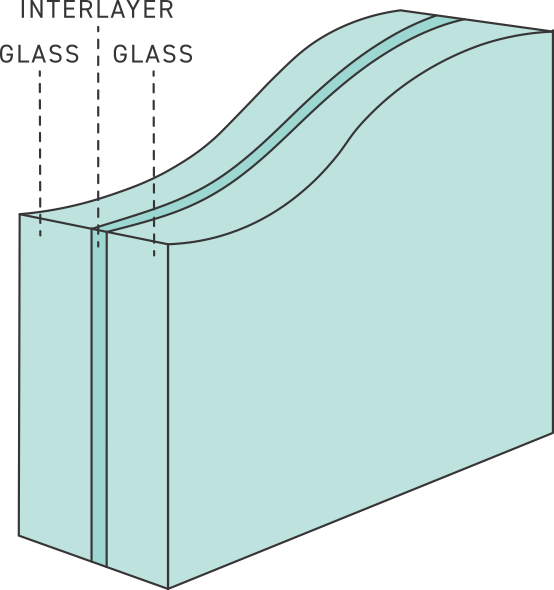
Image courtesy of Floodproofing.com
Custom laminated glass is a key material in floodproof window systems.
From an appearance standpoint, stainless steel or aluminum frames are most common with multiple finishes and colors available to blend with glazing systems in the rest of the building. There are also options for decorative frames and mullions where those are desired. It is also possible to fabricate multiple frame configurations depending on the application and the nature of the window openings. Such details and options are best discussed and reviewed with a manufacturer during the design process.

Photo courtesy of Floodproofing.com
Metal frames provide the means to connect the window to the building.
Beyond the products and materials provided by the manufacturer, there are also other items such as anchors or fasteners that are needed to hold floodproof window systems in place – just as with conventional window systems. In this case, manufacturers can provide fully engineered anchoring specifications indicating the type of fasteners that will work with their products and the types of substrates that they are suitable for. Similarly, installation instructions for those fasteners/ anchors can be provided indicating the spacing of them and the minimum penetration depth needed. All of this is important because proper anchoring of these heavy window units is needed to transfer loads properly to the building structure and not pass undue stresses onto other materials.
Glass Flood Walls
Preventing or containing flood waters on a building site or even in a public outdoor space is also a demonstrated need in many locations. The not-for-profit organization known as the Waterfront Alliance in New York City has looked at a variety of strategies in this regard. They have developed the WEDG program which looks at ways to blend the water’s edge with human activity. (https://wedg.waterfrontalliance.org/) Foremost among their strategies is a cooperative, natural, and often passive means to create sites along the water that enhance their use while protecting from flooding and harm.
A particular technique that is consistent with ongoing, cooperative use and protection, is the incorporation of low, permanent walls that are capable of keeping floodwater at bay. It has been recognized further that making such walls as visually unobtrusive as possible would be quite desirable. But what if they were visually transparent? That’s the focus of glass flood walls – use them in site or landscape designs to create flood barriers that still retain visibility.
Glass flood walls can act as a decorative, but transparent, “fence,” that protects a site near an ocean, bay, or riverfront. As such, it can serve a dual purpose to contain a site (i.e., boundaries of a park), keeping people either inside or outside while also serving to stop floodwaters. Installation of glass flood walls is feasible on sea walls or bulk heads to add additional protection without blocking the view.
Glass Flood Wall Attributes
Glass flood walls act the same way floodproof glass windows do, just located on the site instead of in the building. They create a permanent, passive system that is always ready and does not need to be deployed. They can readily be designed and installed to meet all applicable regulatory standards. They can be engineered and fabricated to withstand hydrostatic pressure and impact loads from floating debris.
Materials for glass flood walls are similar to those for floodproof window systems. The glass is custom laminated suited to the particular requirements of a project. Frame materials include aluminum, structural extruded aluminum, or stainless-steel type 304 or 316. Structural stainless-steel complying with ASTM A240 is also an option. Gaskets and sealants are just as critical here as they are in windows and are provided as well by the manufacturer. This combination of proven materials means that the total system is extremely resistant to environmental corrosion as well as the onslaught of flooding. Aesthetically, the size, configuration and color of the framing can be custom assembled to suit the design scheme for the project. It is also possible to work with the aesthetics of the frames based on an inside or outside covering of the frame with the glazing system.
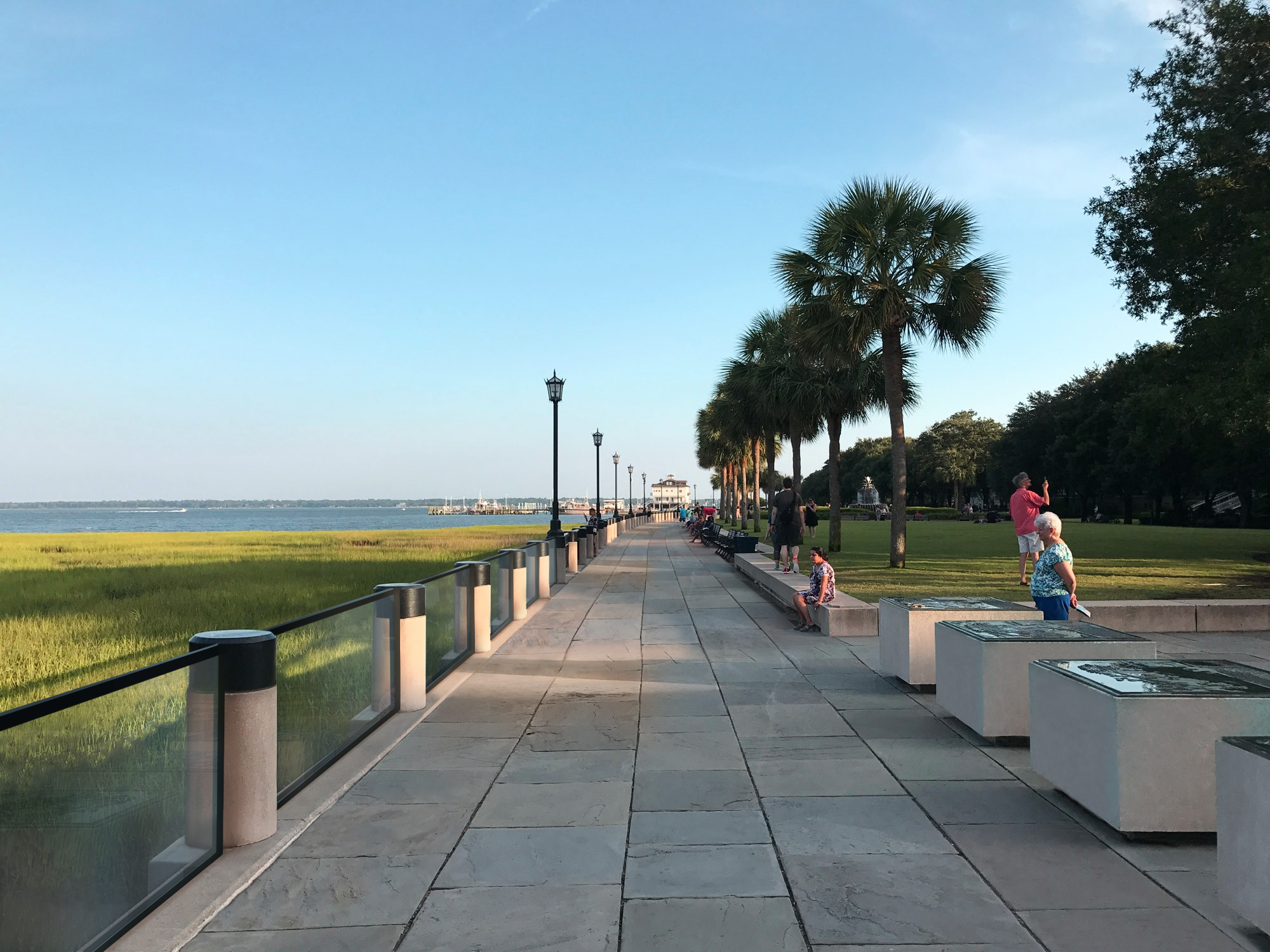
Photo courtesy of Floodproofing.com
Glass flood walls provide a permanent barrier to flood waters without sacrificing visibility.
Custom Systems
Beyond standard floodproof windows and glass flood walls, there are other options that are possible using the same or similar product design and fabrication methods. These can include the following custom fabrication systems.
- Curved Window Some building designs call for curved windows or glass walls, particularly in retail or hospitality design. Some manufacturers have the capability to provide such curved glass systems that are also floodproof. Some of the possible attributes of curved systems include a clear view of up to nearly 470 square feet in a single section. It is possible to combine multiple sections into a multi-curve design. Low-iron glass can be used to maximize the quality of view and avoid any coloration from the glass. Relatedly, the glass can have custom printing to enhance the viewing experience. The frames can be custom fabricated in aluminum or stainless steel. All of this can be assembled to resist fairly high pressures on the order of 120 pounds per square foot.
- Walkable Skylights Some building designs, whether new or existing, incorporate skylights into walkable surfaces. This was done historically on sidewalks above vaults or basement spaces below or done inside buildings to help stream natural light to spaces that otherwise would have none. These situations can be desirable from a design standpoint but create real concerns if they need to resist flooding. Here again, custom floodproof glass systems can provide a solution. Manufacturers have produced approved products up to 132 square feet with a weight capacity of 200 pounds per square foot. They can accommodate virtually any custom shape, including the ability to bend the glass up to 90 degrees in some cases. All of these design options are available and the systems can still be rated for design pressures of up to 120 pounds per square foot.
Cost Comparison
All building projects involve a discussion of cost and floodproofing projects certainly do as well. Keep in mind though, that when considering different flood proofing options, it is quite important to understand all the costs associated with any solution. For example, in large commercial buildings, deployable active panels may be seen as less expensive than passive systems in terms of first costs. However, they will require the construction of a large amount of dedicated storage space that needs to be considered as part of the overall first cost. Furthermore, they will take hours for a team of people to deploy which creates an ongoing operating cost to the owner. To assist in this assessment of cost, calculator tools are available to help layout the lifetime costs of different systems and allow an easier comparison floodproofing options for a project. These calculators include three types of cost factors: 1) the Initial Investment including the design, engineering, product/material costs plus amounts for shipping and installation; 2) Lifetime costs including depreciation, maintenance, storage, and required annual tests; 3) Deployment costs which will understandably vary depending on the number of floodproofing products used and the number of flood events. Using the above as a basis, let’s consider an example of protecting eight 4-by-6-foot openings, comparing only floodproof window systems against traditional windows protected by 4-foot-tall flood panels.
- The passive approach is to use eight 4-by-6-foot floodproof window systems.
- The initial investment is estimated at $17,344 per window, installed or a total of $138,752.
- The annual upkeep for this system is $0.
- The 5-Year cost of ownership is therefore $138,752.
- The active approach is to use traditional windows and deploy 4-foot-tall flood panels around the outside of the windows.
- The initial investment in this case is estimated at $100,544.
- The annual upkeep for this system is estimated at $8,274 per year.
- The 5-Year Cost of Ownership is thus $141,914.
In this example, then, the passive solution shows a lower cost of ownership than the active system. It also demonstrates that the return on investment for the passive system is less than five years compared to the active solution.
Conclusion
Designing buildings to be resilient in the face of flooding has been shown to require an understanding of basic principles as well as regulatory requirements. Several types of passive systems have been explored including floodproof window systems, glass flood walls, and custom solutions. The cost effectiveness of passive systems has been demonstrated as has their performance. Design professionals seeking integrated, coordinated dry floodproofing systems can therefore benefit from learning more about such passive systems for use in their own flood-resistant building projects.
Case Studies
This section will look at two case studies that illustrate the latest technology integrations for extruded aluminum and showcases the way manufacturers worked with designers to execute the projects.
Peter J. Arsenault, FAIA, NCARB, LEED-AP is a nationally known architect and a prolific author advancing sustainable residences through better design.www.pjaarch.com, www.linkedin.com/in/pjaarch


